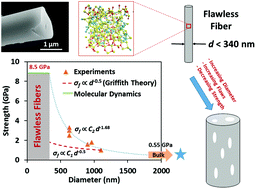Mechanical size effects of amorphous polymer-derived ceramics at the nanoscale: experiments and ReaxFF simulations†
Abstract
Here we report an unprecedented mechanical size effect at the nanoscale in polymer-derived ceramic (PDC) nanofibers. Silicon oxycarbide (SiOC) PDCs were fabricated as micro- and nanofibers without the aid of fillers. By decreasing the size of SiOC ceramic fibers from 1.1 μm to 630 nm (reduction of 74%), the strength of nanofibers nearly tripled, going from ∼1 GPa to ∼3.3 GPa. This increase in strength exceeds the predictions of the Griffith theorem, which relies on the length-scale dependence of energy release rate during crack propagation, suggesting a reduction in flaw size more than proportional to sample size. Given the crosslinked and amorphous nature of SiOC PDCs, flaws are likely microcracks and voids, which form during polymer degassing as it is pyrolyzed to PDC nanofibers. A reduction in sample size may favor degassing via diffusion, preceding bubble and void formation. We developed a new reactive force field (ReaxFF) with parameters for Si/O/C/H/N to study the mechanics of PDCs in extreme cases where no void is present. The models and experiments compare favorably in terms of the elastic modulus. The simulations suggest a strength of ∼8.5 GPa for a “flawless” structure, which is in line with extrapolated experimental results, with C–C breakage as the root cause of failure. This work clearly shows the benefits of utilizing nanoscale components as building blocks of superstrong PDC structures.



 Please wait while we load your content...
Please wait while we load your content...